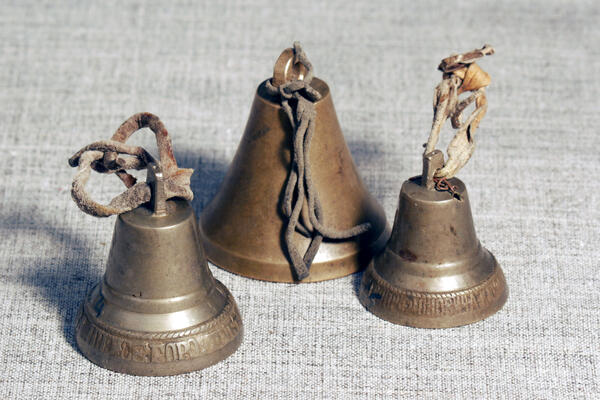Bells are an important part of the traditional NEnets culture, they were often used as an amulet and decoration, for reindeer herding and ritual ceremonies. It is not precisely known when bells came into the Nenets’ life. Many historians agree that it happened when Novgorod merchants came to Yamal, in the beginning of the 11th century.
Even babies had their personal bells hanging above their cradles, intended for calming them down with jingle when they cried. A child under 5 had bells sewn to his outer clothing sleeves. He considered it as a funny toy while his mother, busy with household duties, could always tell where he was by the sound. Young women braided bells into their hair for decoration and stately deportment, as bells helped keeping their backs straight. On the day of matchmaking, when a groom took a bride to his camp, a woman’s sledge was festively decorated with red ribbons and bells.
The Forest NEnets bought or traded shaft-bow bells at fairs and these bells had signal and decorative functions. They hung on a harness, belts and a shaft bow, that’s why they are called “shaft-bow bells”. When driving fast, a clapper swung and hit the inner part of a bell producing the sound one could hear from a distance. The NEnets herders put collars with bells on baby-reindeers to scare away wolves and other predators, only that method sometimes didn’t work.
Every Forest NEnets herd has a special domesticated reindeer to establish connection between a human and the other animals. The Nenets can tell many stories when such a reindeer saved its owner. If it comes to a chum before the others, the bell chimes alert of some danger.
The museum exposition displays the shaft-bow bells provided to the fond by Yenasyata Pyak, a Rychi-Yakha camp resident.
Even babies had their personal bells hanging above their cradles, intended for calming them down with jingle when they cried. A child under 5 had bells sewn to his outer clothing sleeves. He considered it as a funny toy while his mother, busy with household duties, could always tell where he was by the sound. Young women braided bells into their hair for decoration and stately deportment, as bells helped keeping their backs straight. On the day of matchmaking, when a groom took a bride to his camp, a woman’s sledge was festively decorated with red ribbons and bells.
The Forest NEnets bought or traded shaft-bow bells at fairs and these bells had signal and decorative functions. They hung on a harness, belts and a shaft bow, that’s why they are called “shaft-bow bells”. When driving fast, a clapper swung and hit the inner part of a bell producing the sound one could hear from a distance. The NEnets herders put collars with bells on baby-reindeers to scare away wolves and other predators, only that method sometimes didn’t work.
Every Forest NEnets herd has a special domesticated reindeer to establish connection between a human and the other animals. The Nenets can tell many stories when such a reindeer saved its owner. If it comes to a chum before the others, the bell chimes alert of some danger.
The museum exposition displays the shaft-bow bells provided to the fond by Yenasyata Pyak, a Rychi-Yakha camp resident.



